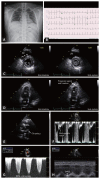Role of echocardiography in acute pulmonary embolism
- PMID: 36587934
- PMCID: PMC10338244
- DOI: 10.3904/kjim.2022.273
Role of echocardiography in acute pulmonary embolism
Abstract
Although pulmonary embolism (PE)-related mortality rate has decreased because of prompt diagnosis and effective therapy use, acute PE remains a potentially lethal disease. Due to its increasing prevalence, clinicians should pay attention to diagnosing and managing patients with acute PE. Echocardiography is the most commonly used method for diagnosing and managing acute PE; it also provides clues about hemodynamic instability in an emergency situation. It has been validated in the early risk stratification and impacts management strategies for treating acute PE. In hemodynamically unstable patients with acute PE, echocardiographic detection of right ventricular dysfunction is an indication for administering thrombolytics. In this review article, we discuss the role of echocardiography in the diagnosis and management of patients with acute PE.
Keywords: Diagnosis; Echocardiography; Management; Pulmonary embolism.
Conflict of interest statement
No potential conflict of interest relevant to this article was reported.
Figures


Comment in
-
Echocardiography in acute pulmonary embolism.Korean J Intern Med. 2023 Jul;38(4):566-567. doi: 10.3904/kjim.2023.006. Epub 2023 Jun 9. Korean J Intern Med. 2023. PMID: 37291837 Free PMC article. No abstract available.
Similar articles
-
Critical Management of Haemodynamically Unstable Acute Pulmonary Embolism in COVID-19.Acta Med Indones. 2024 Oct;56(4):530-536. Acta Med Indones. 2024. PMID: 39865051
-
[Pulmonary embolism].Dtsch Med Wochenschr. 2015 Jan;140(2):89-96. doi: 10.1055/s-0041-100003. Epub 2015 Jan 22. Dtsch Med Wochenschr. 2015. PMID: 25612280 German.
-
Role of echocardiography in managing acute pulmonary embolism.Heart. 2019 Dec;105(23):1785-1792. doi: 10.1136/heartjnl-2019-314776. Epub 2019 Aug 22. Heart. 2019. PMID: 31439657 Review.
-
Management of Right Ventricular Failure in Pulmonary Embolism.Crit Care Clin. 2020 Jul;36(3):505-515. doi: 10.1016/j.ccc.2020.02.006. Epub 2020 May 1. Crit Care Clin. 2020. PMID: 32473695 Review.
-
Diagnosis and management of life-threatening pulmonary embolism.J Intensive Care Med. 2011 Sep-Oct;26(5):275-94. doi: 10.1177/0885066610392658. Epub 2011 May 23. J Intensive Care Med. 2011. PMID: 21606060 Review.
Cited by
-
Clinical Profile and Outcomes of Pulmonary Embolism in Central Iran: A Retrospective Cohort Study.Arch Iran Med. 2024 Dec 1;27(12):667-673. doi: 10.34172/aim.31907. Epub 2024 Dec 1. Arch Iran Med. 2024. PMID: 39891454 Free PMC article.
-
The Zurkurnai ECG Pattern: A Novel ECG Pattern of the High-Risk Features of Acute Pulmonary Embolism.Cureus. 2024 Jan 24;16(1):e52889. doi: 10.7759/cureus.52889. eCollection 2024 Jan. Cureus. 2024. PMID: 38274596 Free PMC article.
-
Pulmonary Embolism in Acute Ischaemic Stroke: Evolving Evidence, Diagnostic Challenges, and a Novel Thromboinflammatory Axis Hypothesis.Int J Mol Sci. 2025 Jul 14;26(14):6733. doi: 10.3390/ijms26146733. Int J Mol Sci. 2025. PMID: 40724982 Free PMC article. Review.
-
Right Ventricular Longitudinal Strain-Related Indices in Acute Pulmonary Embolism.Medicina (Kaunas). 2024 Sep 27;60(10):1586. doi: 10.3390/medicina60101586. Medicina (Kaunas). 2024. PMID: 39459372 Free PMC article. Review.
-
In-Hospital versus Out-of-Hospital Pulmonary Embolism: Clinical Characteristics, Biochemical Markers and Echocardiographic Indices.J Cardiovasc Dev Dis. 2024 Mar 28;11(4):103. doi: 10.3390/jcdd11040103. J Cardiovasc Dev Dis. 2024. PMID: 38667721 Free PMC article.
References
-
- Agnelli G, Becattini C. Acute pulmonary embolism. N Engl J Med. 2010;363:266–274. - PubMed
-
- Keller K, Hobohm L, Ebner M, et al. Trends in thrombolytic treatment and outcomes of acute pulmonary embolism in Germany. Eur Heart J. 2020;41:522–529. - PubMed
-
- Wendelboe AM, Raskob GE. Global burden of thrombosis: epidemiologic aspects. Circ Res. 2016;118:1340–1347. - PubMed
-
- Virani SS, Alonso A, Benjamin EJ, et al. Heart disease and stroke statistics-2020 update: a report from the American Heart Association. Circulation. 2020;141:e139–e596. - PubMed
-
- Konstantinides SV. Trends in pulmonary embolism outcomes: are we really making progress? J Am Coll Cardiol. 2016;67:171–173. - PubMed
Publication types
MeSH terms
Substances
LinkOut - more resources
Full Text Sources
Medical
